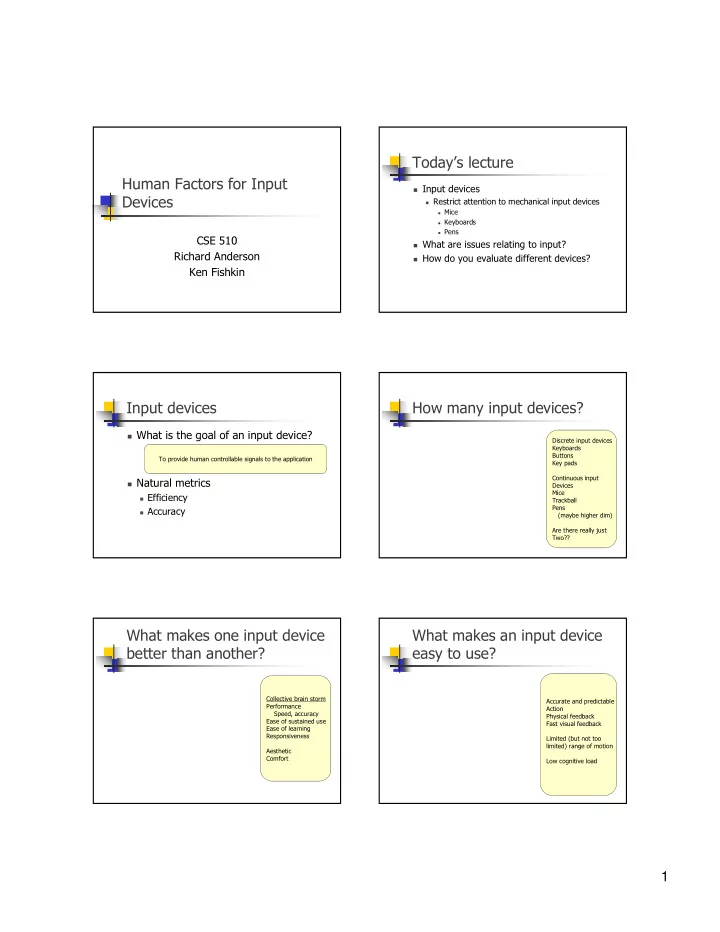

Today’s lecture Human Factors for Input ! Input devices Devices ! Restrict attention to mechanical input devices ! Mice ! Keyboards ! Pens CSE 510 ! What are issues relating to input? Richard Anderson ! How do you evaluate different devices? Ken Fishkin Input devices How many input devices? ! What is the goal of an input device? Discrete input devices Keyboards Buttons To provide human controllable signals to the application Key pads Continuous input ! Natural metrics Devices Mice ! Efficiency Trackball Pens ! Accuracy (maybe higher dim) Are there really just Two?? What makes one input device What makes an input device better than another? easy to use? Collective brain storm Accurate and predictable Performance Action Speed, accuracy Physical feedback Ease of sustained use Fast visual feedback Ease of learning Responsiveness Limited (but not too limited) range of motion Aesthetic Comfort Low cognitive load 1
Toleration of Delays Job completion times ! How fast is fast enough? ! Effect of execution on completing a job This depends on the Software development time user experience. Distinction Task completion Compiling Payroll entry Loading page Roughly linear Limited effect Physical – causality Billiards example Ink following pen Anecdote Most excited Ed 9.2 K modem Compilation time Database Update time The basic point to make is that there are considerations about IO devices beyond the run time Response time RSI of the application. ! Repetitive Strain Injury ! What is it? ! What causes it? ! How to avoid it? Keyboard facts Pointer Facts Mouse QWERTY Dominant desktop pointing 5 ks / sec (expert 15) device Dvorak +33% Accurate positioning Corded 30 ks/sec Stationary Info theory Variety of buttons, Compare with Piano scroll wheels Ergonomics issues Physical issues optimal for three hands Size, pressure, shape, Alternate pointing devices Finish, auditory, travel for restricted area Time, spacing touchpad, trackpoint, trackball Numeric keypads, Cursor control Game controls Lack of consistency In layout Most devices hybrid Pointing + discrete 2
Stylus Facts Device issues Pen input and touch Screen Technologies covered ! Efficiency of completing task on Monday Potentially higher ! Speed dimensions than mouse Much better fine control ! Accuracy (writing with a mouse) ! Speed vs Accuracy Direct input on screen Error rate pros and cons ! What does the curve look like different metaphors from desktop ! Where are you on the curve? Touch screen Natural for some apps Completion time Ideal for public devices Lack of precision Adoption Socio-economic issues ! Learning curve ! Variety of users ! Novice ! Advantages of general adoption ! Intermediate ! Inertia ! Expert ! Cost of change outweighs benefits of change Evaluation of input devices Fitts’ law ! Is it possible to rigorously evaluate ! A tasks movement difficulty is given by input devices? ID = log 2 (2A / W) ! Study performance of atomic tasks with ! ID – index of difficulty specific devices. ! A – amplitude of the move ! Look for measures of complexity ! W – width of the target region ! Predictive? ! Comparative? ! Models of actions and devices 3
Experiment Standard experiment W ! Compute Movement Time (MT) for range of A’s and W’s ! Plot ID vs. MT A ! Computer linear fit ! MT = a + b ID Cursor ! Extremely good fit in empirical tests ! But plenty of room for criticism Target Issues What does the law say? ! High correlations have been reported ! Relative accuracy determines difficulty ! E.g., r = .992, MT = 53 + 148 ID ! Sometimes the intercept have been large ! E.g., r = .91, MT = 1030 + 96 ID ! Comparison of Pie menus and linear ! The model breaks down if W > 2A menus? ! So maybe use ID = log 2 (A/W + 1) Where the law breaks Extensions ! Large distances ! Considering accuracy in the model ! ½ inch target at 1 inch vs ½ mile target at ! Adding additional parameters 1 mile ! E.g., movement time ! Small distances ! Suggests zero movement for selection from pie menus ! Ignores minimum targeting range 4
Implications ! Supporting measurement based research ! Allow more rigorous conclusions ! The mouse is optimal ! Targeting the mouse has same coefficients as targeting the hand 5
Recommend
More recommend